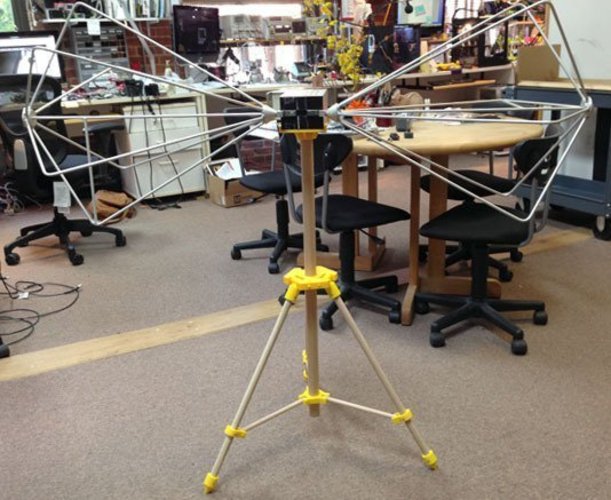
Tripod
pinshape
I need a robust, stable, non-metallic tripod for RF/EMC testing that won't break the bank. Commercially available tripods are pricey, but this one is affordable and rock-solid. I don't require height or tilt adjustments, although you could definitely design a tilt head if needed. The top of the post sits 36 inches above the floor using the dowel lengths specified in the instructions. All plastic parts except the top hub were printed on an Afinia. The top hub is slightly too large for the Afinia so I printed it on a Zortrax M200; it could probably be trimmed to fit on the Afinia if necessary. The source files can be found and edited at https://tinkercad.com/things/dg7uzMdPeZh. Instructions Use oak dowels, not pine or fir. The center post is 1-1/4" in diameter, the legs are 3/4", and the braces are 1/2". The design is highly configurable by choosing dowel lengths, and it's easy to apply the Pythagorean theorem to get whatever you want. In my prototype, the center post is 33 inches long, the legs are 21-1/2" long, and the braces are 9-1/2" long. The top hub is pinned to the center post (about 16 inches from the top) with three counter-bored #8 x 3/4" pan-head sheet metal screws. The leg pivots, leg straps, and feet are pinned to the legs with #6 x 5/8" pan-head sheet metal screws. Getting the straps exactly at a 90-degree angle to the top pivot axis is crucial. For the hinged joints, you could use bolts or dowels, but I printed my own dowel pins. They're a pretty good friction fit as-is, but maybe I'll solvent-weld them in place once I'm finished. Drilling the braces with 4mm holes for the hinge pins is the trickiest part of the assembly; I recommend using a V-block and drill press. The holes at each end need to be parallel with one another or assembly will be difficult. I printed all the parts in ABS. The dowel pins should be oriented horizontally so the layers run longitudinally. The leg pivots should be printed with the pivot axle hole vertical. I printed the feet pointy-end-up, and everything else "flat". My workspace is carpeted, so the pointy feet work great. If you plan to use this on smooth floors, you might want to design rubber-grip feet.
With this file you will be able to print Tripod with your 3D printer. Click on the button and save the file on your computer to work, edit or customize your design. You can also find more 3D designs for printers on Tripod.
